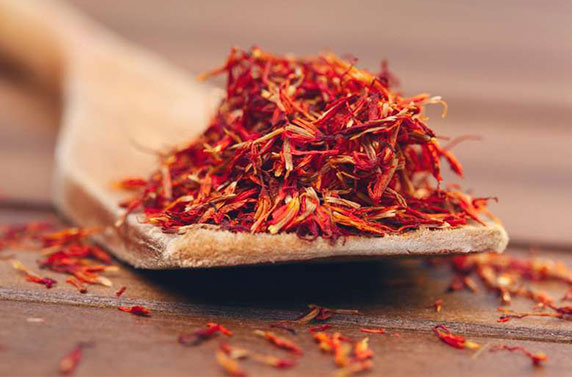 Saffron derives from Arabic za’fran “be yellow”. The Hindi and Sanskrit names have been derived from the Northern Indian region Kashmir, where old saffron was produced. Saffron is the most expensive spice in the world. In production countries the price is much lower, but so is the quality. Saffron’s aroma is unique and there is no substitute for it. Saffron is the slender, dried, reddish-brown, flattened stigma of a small crocus of the iris family. Saffron is cultivated from the Western Mediterranean (Spain) to India (Kashmir). In much smaller scale, saffron is also cultivated in Italy and Greece (Crete). Of the Western and Central Asian cultivation areas, Iran is most productive and together with Spain and Iran produces more than 80% of the world’s production. The saffron is grown in India- Kashmir has a particularly high reputation but is hardly available outside India.
Saffron derives from Arabic za’fran “be yellow”. The Hindi and Sanskrit names have been derived from the Northern Indian region Kashmir, where old saffron was produced. Saffron is the most expensive spice in the world. In production countries the price is much lower, but so is the quality. Saffron’s aroma is unique and there is no substitute for it. Saffron is the slender, dried, reddish-brown, flattened stigma of a small crocus of the iris family. Saffron is cultivated from the Western Mediterranean (Spain) to India (Kashmir). In much smaller scale, saffron is also cultivated in Italy and Greece (Crete). Of the Western and Central Asian cultivation areas, Iran is most productive and together with Spain and Iran produces more than 80% of the world’s production. The saffron is grown in India- Kashmir has a particularly high reputation but is hardly available outside India. Saffron flower is more important in Central Asia and Northern India and is used extensively for rice dishes. Even the North Indian biryanis are relished due to the fragrant and aromatic flavor added by the saffron. Indian sweets like, Kheer, Ras Malai, Indian Yogurt Drink (Lassi), Butter Lassi (Makhaniya Lassi) have an everlasting culinary impression due to the saffron added to it. The use of saffron in sweet dishes is famous in the desert regions of Jodhpur in Rajasthan in the Indian sub continent.
Saffron is unique among spices due to its aroma. It is water-soluble and when added to the dish, gives a pure and homogeneous color. In high dosage, saffron exhibits toxic qualities. However, due to its high price, saffron poisoning is very rare.
Often called ‘The Golden Spice’, saffron has a history rooted in antiquity. It has always held a very special place for its extraordinary medicinal and flavoring properties as well as for being a striking yellow dye. Indian saffron is cultivated on a large scale in the Jammu & Kashmir valley whose cool dry climate and rich soil with excellent drainage and organic content make the location an ideal thriving ground for this spice. By every standard, Indian saffron is considered superior to its foreign counterparts.
Saffron Flower is a well known flower plant which belongs to the botanical family, Iridaceae. A spice made from the dried stigma of the flower of saffron crocus is considered the world`s most expensive spice. The plant has various uses including culinary and medicinal and is found quite extensively throughout India. The origin of saffron dates back to more than 3,000 years and is mentioned in various historical documents found in the Mediterranean, Asian and European countries. The Chinese historical documents of the 3rd century AD referred saffron to have a Kashmiri provenance.
Call Us or Fill the Form
Maharashtra 400074
